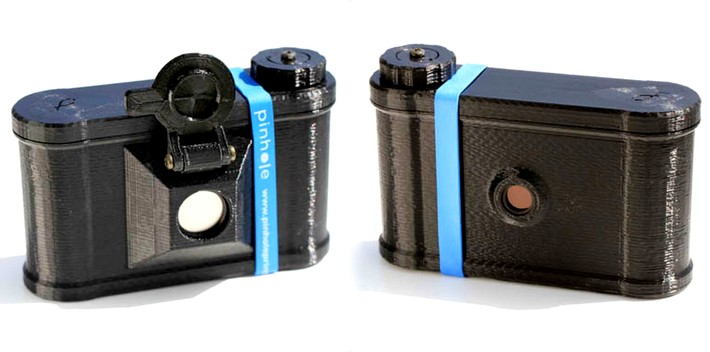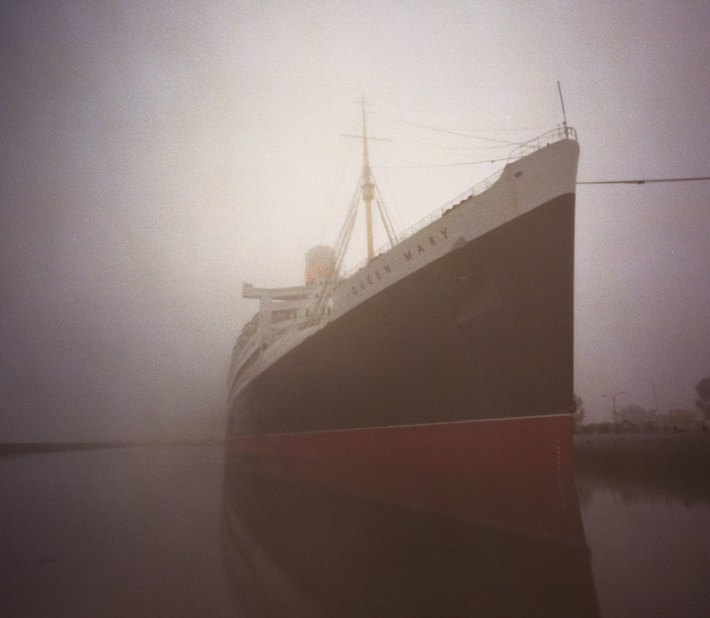Clint O'Connor has devoted his life to driving change in the world and has never been short of ideas how to do it. He got his B.A. degree in Physics, went to MIT for Electrical Engineering supplemental courses and then started a PhD degree, but went on to start a company instead. Afterwards he worked for Dell and retired as a Distinguished Technologist having 35 US and 9 international patents to date.
As a deaf man, Clint always recognized the importance of the visual impact of images. He loves the unique perspective of pinhole cameras and the analog quality of film. Pinhole cameras and camera obscuras made a significant contribution to the early development of photography. Clint was making pinhole cameras from cardboard or wood or metal cans until he got a Solidoodle 3D printer in 2013 and was able to make lighter, less expensive and more robust cameras. Firstly, he created Flyer, the first 3D printed camera to be funded by Kickstarter, which is in the New Mexico History Museum now. Then he designed the first 3D printed panoramic pinhole camera Clipper.

Pinhole cameras Flipper 6x6 and Clipper 6x18 displayed at the New Mexico History Museum
Can you recall how or
why you became a maker? or Can you recall how or why you started Pinhole
project?
I’ve been a maker since I was a child - I was always taking things apart and putting them back together, often not in the way the manufacturer intended. I had a little minibike/gocart company in the Apollo moonshot days and started Analytical Engines in the early 80s to make 68000 accelerators for Apple and IBM PCs. Then I became a distinguished technologist for Dell, now retired. I made a lot of my own pinhole cameras from many materials and old cameras, but when I got my Solidoodle 3D printer in 2013, I thought the 3D printer would be ideal for pinhole cameras since the cameras would be light, robust, and relatively inexpensive.

A 3D printed pinhole camera Flyer 6x6
Tell us about the
local scene in Austin TX and in the UK. Who are makers and what do they stand
for?
There are a lot of creative people in Austin! Austin is known on the world music stage for South by Southwest (SXSW) and for tech companies like Dell, Samsung, IBM, and many smaller companies. There is a TechShop in Austin, founded by Jim Newton, which is encouraging the local maker community.
Europe is bigger in the maker scene than the US and I’m still learning what’s going on in the UK. Manchester, of course, is the home of the Industrial Revolution and early computing developments, and it will be interesting to see if new 3D textiles will come out of Manchester.
Really, a maker is a creative person who makes new things out of any materials or old objects at hand. I would say a modern maker’s tools are 3D design and computer-controlled laser cutters, CNC, and 3D printing. Modern making is a mix of additive and subtractive manufacturing with a shift toward additive manufacturing and minimizing waste and energy usage.
Many people believe
the maker movement will have a transformative impact on our future. What are
your thoughts?
Absolutely, when it comes to 3D printing and
forms of additive manufacturing. There
is a great saving in time and energy when all you need are certain processed
materials and a few essential parts, and you can turn out a finished product
ready for use. In 20 years, the
transformation will be nearly as pervasive as the Internet, though many people
may not recognize it directly. There
won’t be a printer in every home, probably, but it will permeate every aspect
of many businesses and shops. Our
children will grow up learning to design in 3D and dream of things we can’t
anticipate today.

Queen Mary in Long Beach taken with a homemade pinhole camera
What part of the
making process excites you the most?
The parts of the making process that excite me
the most are the design & prototyping phases where I visualize the finished
product and attempt to create it. There
are a lot of failures on the way but each iteration solves a new issue, and it
is inspiring to arrive at the final design. Production is much less interesting
to me, as a rule.
How do you approach a
project? Where do you get inspiration from?
Projects
generally find me
. I
get interested in a subject or field, and when I get involved, I think about
how to improve or do it better, and then I get inspired to make a change. I have no shortage of projects and I don’t
ever expect to run out of things to do and make.
What aspects of your
project are unique? Why should it go big?
Quite honestly, pinhole cameras have been
around for centuries. The unique aspect
is that these cameras are 3D printed, the first to be 3D printed and the first
to go on Kickstarter, and that has attracted both photography enthusiasts and 3D
printing enthusiasts. Some people in the
younger generations have never had a film camera. My favourite question from the Kickstarter
project is “where do you buy pinhole film?”
It’s funny from a historical photography context but it is also
illuminating as a perspective on modern digital photography.
Who are the customers
or clients of your project?
I wanted to attract two main groups, beyond
those already interested in and doing pinhole photography. There are enthusiasts who have wandered away
from film (and may have
never tried pinholes before),
and there are people who have never used film.
The 3D printing aspect also attracted people who have or are interested
in 3D printing. I succeeded on both
counts with many comments from backers getting back into film or getting into
film for the first time.

Magnolia Beach Texas taken with Flyer 6x6
What’s the role of 3D
printing in the maker movement?
It’s a fundamental part of the modern maker
movement. It’s the modern hammer, and
everything starts looking like a nail to the modern maker. The question will be
what material can you make it in?
How is 3D printing
helping you bring the idea to life?
3D printing eliminates the labour in hand
making paper or wood cameras, and the plastic is impervious to water
damage. There is still hand labour in
assembling, packing, and shipping the cameras but much of the labour in making
the cameras has been stripped out. Once
the design files are done, I just need to keep the printers running. It is not mass production, though. It’s more work to keep multiple printers
running than to inject plastic – but I can do things I can’t do with injection moulding
so I have fewer parts and less assembly.
What’s your take on
the open source issue in 3D printing industry?
It’s a dilemma and I think it depends on the
circumstances of the designer. Open source is great for everyone and
facilitates new ideas and sharing, providing users are mindful of attribution
and the license specifics. I made my 35mm to 120 film adapters open source (CC
by SA), and anyone can make them or even sell them, and I accept that. Despite the open source license, people are
still purchasing them from me because they either don’t have a printer or don’t
want to print them.
If you are creating a business, open source can
limit your potential revenue. Non-commercial open source licenses theoretically
allow you to share yet be the only maker who can sell it. There have been
numerous cases where people have ignored that. Makerbot and others have started
as open source and then realized they could not continue and also grow big, so
they have moved to a closed source model.
Arduino is a good example, I think, of merging
open source with business needs for a middle of the road approach. The name is
trademarked so while anyone can make Arduino-compatible products, they can’t
call them Arduino unless they pay a reasonable fee to the creators to license
the name.

Magnolia Beach taken with Flyer 6x6
What kinds of objects
have you 3D-printed for your personal needs?
Piggy banks, bird houses for a competition,
fixtures for drilling holes for handles in kitchen cabinets, fixtures for my 3D
printers, watering containers for irons and plants, parts trays, and lots of
calibration cubes. I’m building a camera-based map scanning table now.
How and why did you
get the idea of using kickstarter.com to fund your 3D printing project?
I wanted to get my camera design into the hands
of photographers who hadn’t experienced pinhole photography and give 3D printer
owners something to print other than vases. I wanted Kickstarter to fund the
printers (I already owned one) and enable me to shoot a lot of film for my
photography work. I was hoping for about $5k. It was so popular I ran out of my
projected production in 10 days. I got a second printer and ran out of that in
another 10 days. I could have gone over $40k with more publicity and more printers
but
unlike most
Kickstarters, I limited the rewards to what I was comfortable doing
.
Do you believe in 3D
printing revolution? Why?
3D printing is a true disruptive technology. Many
people deride the idea that everyone will have a printer at home or that
everyone will learn 3D, and thus discount the future impact. As 3D printers can
handle more materials and become cheaper and easier to use, the applications
will expand, and ultimately many current mass produced products will be
replaced by products that are 3D produced or incorporate 3D printing.
I think the true revolution lies among
the young people today who will grow up learning to design in 3D
and
accept that they can make what they want as a matter of course.

Clint O'Connor creator of one of the first 3D printed pinhole cameras
How do you see 3D
printing changing people’s lives in a decade?
It’s very, very hard to accurately see 10 years out. As new technology comes into use, people see new applications and the technology changes as it matures. Certainly I think plastic FDM and resin printers will become common, particularly in schools and households with growing children. New materials will expand the range of applications. Resin printers are easy to run compared with FDM. SLS printers will come down to where it will be practical to go to a school or maker shop and have something made. Mass production will suffer progressively as people are less willing to take a stock product and will demand more customization. Medicine is a ripe field where new developments are being made every year. There will be house printers, car body part printers. We should be able to print circuits within 10 years, embedding the actual wiring into the objects themselves. I think there will be local shops where you can have what you need made, whether it’s a hard to find spare part or a personalized coffee cup, or any number of other objects in plastic, metal, ceramics, etc. Ask me again in 10 years.
Are you a maker? Check out the ongoing challenges!











Comments